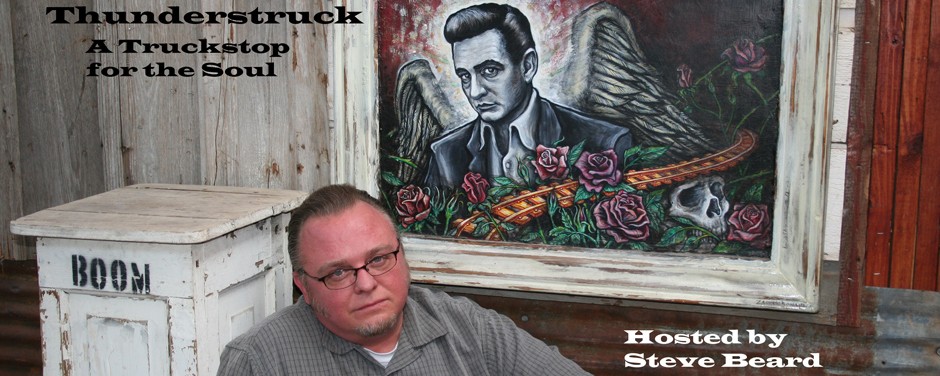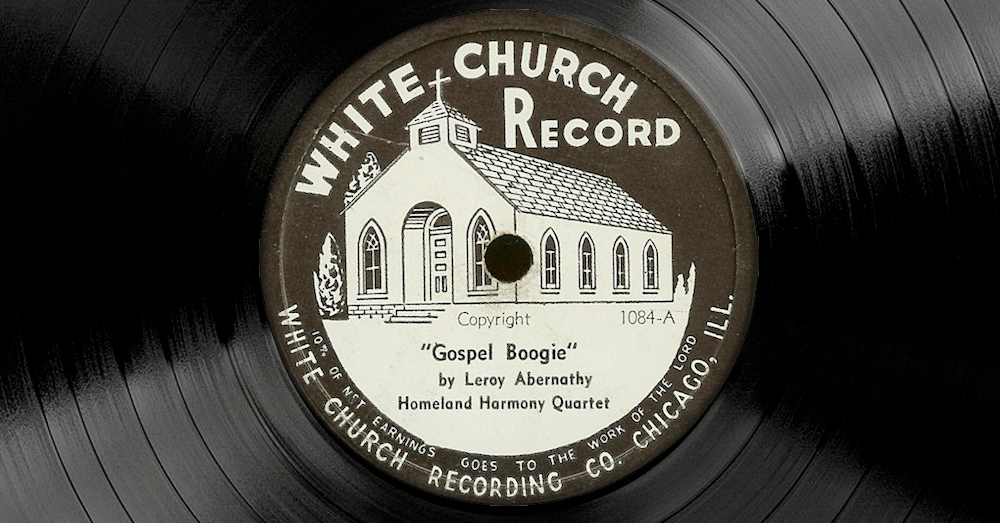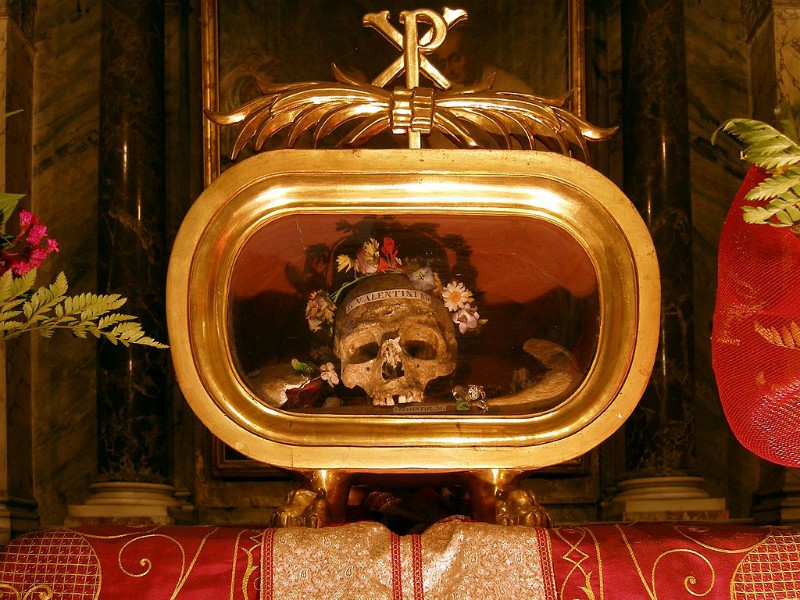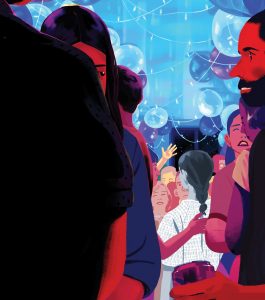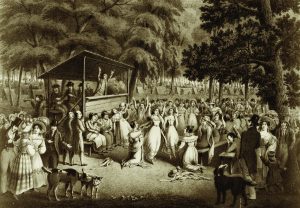 By Winthrop S. Hudson
By Winthrop S. Hudson
Encounter, Winter 1968, Volume 29
“I do believe, without a doubt / The Christian has a right to shout.” [1]
When one thinks of early nineteenth-century Methodists, one immediately thinks of the name which was commonly applied to them. People spoke of Methodists as “shouting Methodists,” and it was a name Methodists were glad to accept and make their own. This is made evident by a song in Stith Mead’s Methodist songbook of 1807, Hymns and Spiritual Songs. It is a song extolling the Methodists, and it was sufficiently esteemed to be placed in the cornerstone of Foundry Methodist Church in Washington, D.C.[2] Entitled “The Methodist,” this spiritual song declares:
The World, the Devil, and Tom Paine
Have try’d their force, but all in vain.
They can’t prevail, the reason is,
The Lord defends the Methodist.
They pray, they sing, they preach the best,
And do the Devil most molest.
If Satan had his vicious way,
He’d kill and damn them all today.
They are despised by Satan’s train,
Because they shout and preach so plain.
I’m bound to march in endless bliss,
And die a shouting Methodist.
What was meant by the term “shouting Methodist”? At the very least, it meant that Methodists were a noisy lot, interrupting the preacher with ejaculations of “Praise the Lord,” “Hallelujah,” and “Amen.” Alexander Campbell declared that the Methodist church could not live without her cries of “glory! glory! glory!” And he reported that “her periodical Amens dispossess demons, storm heaven, shut the gates of hell, and drive Satan from the camp.”[3] But Methodist noise was not limited to ejaculations. Singing and clapping, groaning and crying, praying and exhorting, contributed to the din. In the same songbook of 1807, the initial impression of a convert is reported:
The Methodists were preaching like thunder all about.
At length I went amongst them, to hear them groan and shout.
I thought they were distracted, such fools I’d never seen.
They’d stamp and clap and tremble, and wail and cry and scream.[4]
A later Methodist songbook, The Hesperian Harp of 1848, has a “dialogue song” between a “Methodist” and a “Formalist,” in which the “Formalist” gives a similar picture of the Methodists.
Such groaning and shouting, it sets me to doubting.
I fear such religion is only a dream.
The preachers were stamping, the people were jumping,
And screaming so loud that I nothing could hear.…
The men they were bawling, the women were squalling,
I know not for my part how any could pray.…
Amid such a clatter who knows what’s the matter?
Or who can attend unto what is declared?
To see them behaving, like drunkards, all raving,
And lying and rolling prostrate on the ground.
I really felt awful, and sometimes felt fearful
That I’d be the next that would come tumbling down.
In the end, he did come tumbling down. His heart was “glowing,” Christ’s love was “flowing,” and “peace, pardon, and comfort” he found.[5]
These were the “shouting Methodists,” and it is clear that “shout” was a prominent part of Methodist vocabulary. Nowhere is this more evident than in the refrains of their spiritual songs. “Shout, shout, we’re gaining ground,” they sang. “We’ll shout old Satan’s kingdom down.”[6] The word would appear in casual conversations. An aged person, for example, would rejoice at being still able “to shout,” and a death would be recorded: “She went off shouting.”[7]
What did it mean to “shout”? “Shouting” was never mere noise. “Shouting” was neither preaching nor exhorting. Exhorting was a noisy performance, but the word had a technical meaning that was not broad enough to include even the “action sermon.” Nor was “shouting” praying, not even when praying became a babel of unison but individual prayers, not even when praying became a din as a congregation sought to “pray down” a sinner or to contend in prayer for the souls of the penitent.
“Shouting” was praise or, as it was often called, rejoicing. Both its practice, including the clapping of hands, and its meaning was partly shaped by Old Testament texts.[8] Initially “shouting” was probably no more than uttering ejaculations of praise. But it quickly became, in addition to these ejaculations, a type of singing, a type of song, a “shout song,” or just a “shout.”[9]
If a “shout” was an ejaculation of praise and a song of rejoicing, it also became the name of a religious service, a service of praise, a praise meeting. People spoke of going to “preaching,” of going to a “class meeting,” and of going to a “shout,” a praise meeting. “When we get home,” they sang, “we’ll have a shout in glory.”[10]
Finally, for some, a “shout” became a dance, a shuffling of the feet, a jerking of the head, a clapping of the hands, and perhaps an occasional leap. Most often it was a circular march, a “ring shout.” Thus Webster’s Third New International Dictionary defines “shout” as “to give expression to religious ecstasy, often in vigorous, rhythmic movements (as shuffling, jumping, jerking) specifically, to take part in a ring shout.”
The term “shouting” suggests confusion, and this was the initial impression one gained of Methodist meetings. Devereux Jarratt, a Methodist himself prior to the separation of 1784, reported of a Methodist gathering in 1776 that “the assembly appeared to be all in confusion, and must seem to one at a little distance more like a drunken rabble than the worshippers of God.”[11] The development of a specialized vocabulary with highly technical meanings, on the other hand, suggests that there were patterns of group activity in the midst of the confusion, a degree of order and method in the apparent madness. Perhaps the patterned activity of the folk religion of the Methodists can best be grasped by viewing it through the lens provided by the Kentucky Revival.
The Kentucky Revival represented an extension of Methodist enthusiasm to members of other denominations. If the beginning of the revival can be dated, it occurred in 1800 when John McGee, a Methodist itinerant, stepped forward at the close of a Presbyterian sacramental service after the departure of the ministers and began to exhort those who remained in the meeting house. A woman cried out, and McGee left the pulpit to go to her.
Several spoke to me: “You know these people. Presbyterians are much for order. They will not bear this confusion. Go back and be quiet.” I turned to go back and was near falling, [but] the power of God was strong upon me. I turned again, and losing sight of fear of man, I went through the house shouting and exhorting with all possible ecstasy and energy, and the floor was soon covered by the slain.[12]
The excitement quickly swept across the state, reaching a peak at the Cane Ridge meeting the following year. At Cane Ridge, a sympathetic participant observed a Presbyterian minister behaving “much like a Methodist”—speaking and singing and exhorting in a lively and ecstatic fashion. The next day another Presbyterian minister gathered a large audience, and it was noted that “many of them appeared to be Methodists. They shouted before he was done, but afterwards they shook hands and got into a singing ecstasy. There was a great shaking of hands and praying and exhorting.”[13] Peter Cartwright later commented that “Presbyterian, Methodist, and Baptist ministers” were “all united in the blessed work” at Cane Ridge, and “when they returned home to their different congregations and carried news of this mighty work, the revival spread rapidly throughout the land.”[14]
The great utility of the Kentucky Revival as a case study for understanding the type of enthusiastic religious expression most commonly associated with the Methodists is that the accounts of the Kentucky Revival are numerous, ample, and detailed. Most of the accounts, to be sure, do emphasize the general confusion and focus attention on the striking behavior of single individuals. Here and there in these accounts, however, one finds bits of information which provide clues to the patterns of group behavior. One of the most useful documents in this respect reports Lemuel Burkitt’s account of the “weak and simple means” which are used to “effect great purposes.” Burkitt was a North Carolina Baptist, and he had returned from a visit to Kentucky in 1801, bringing news of the “general stir” that was taking place there “almongst all ranks and societies of people.”[15] His return was followed by a great revival among the North Carolina Baptists of the Kehukee Association and an account, published in 1803, stressed three instrumentalities that had served to kindle the “sacred flame.”
Singing was attended with a great blessing. Elder Burkitt published two or three different pamphlets which contained a small collection of spiritual songs, some of which he had brought from the western countries. They were in very great demand.… At every meeting, before the minister began to preach, the congregation was melodiously entertained with numbers singing delightfully, while all the congregation seemed in lively exercises. Nothing seemed to engage the attention of people more [than] these melodious songs.…
Shaking Hands while singing was a mean, though simple in itself, for to further the work. The ministers used frequently, at the close of worship, to sing a spiritual song suited to the occasion and go through the congregation and shake hands with the people while singing. And several, when relating their experience at the time of their admission into the church fellowship, declared that this was the first means of their conviction. The act seemed so friendly, the ministers appeared so loving, that the party with whom the minister shook hands would often be melted in tears. The hymn…,
Take your companion by the hand,
And all your children in the band.
many times had a powerful effect.
Giving the people an invitation to come up to be prayed for was also blessed. The ministers usually, at the close of preaching, would tell the congregation that if there were any persons who felt themselves lost and condemned, under the guilt and burden of their sins, that if they would come near the stage and kneel down, they would pray for them. Shame at first kept many back, but as the work increased numbers, apparently under strong, conviction, would come and fall down before the Lord at the feet of the ministers and crave an interest in their prayers, sometimes twenty or thirty at a time.…It had a powerful effect on the spectators to see their wives, their husbands, children, neighbors, etc. so solicitous for the salvation of their souls, and was sometimes a means for their conviction.…The act of coming to be prayed for in this manner had a good effect on the persons who came, in that they knew the eyes of the congregation were on them, and if they did fall off afterwards it would be a disgrace to them and cause others to deride them. This, therefore, was a spur to push them forward.[16]
These “weak and simple means,” described by Burkitt, are helpful in discerning the patterned activity of the Kentucky Revival.
The singing of “spiritual” or “melodious” songs, simplified texts with repetitive refrains set to lively folk tunes, is stressed in reports of the Cane Ridge and other camp meetings. Presbyterian John Lyle tells how, after one minister had finished preaching, other ministers would step forward to pray and exhort, and then set people to singing.[17] At Cane Ridge it was requested that there be no singing during sermons. But with four or more sermons being preached simultaneously—in the meeting house, in the tent, and at locations elsewhere in the open air—and with other small groups praying and singing and exhorting around those who bad been “struck lifeless,” the effort to control the singing was impossible. One attendant reported that “there was singing in one part of the camp [or another] without intermission from the time I first arrived until I left.…, a term of seventy-two hours.”[18] At an earlier Presbyterian sacramental meeting, “without any regard to former rules of order,” the whole night had been spent in singing, praying, and exhorting.[19] Opponents of the Revival, according to Colonel Robert Patterson, contended that the “exercises”—leaping, jumping, jerking, falling—were to be attributed principally to “the melody of the singing.”[20]
The practice of shaking hands was equally conspicuous. John Lyle tells how he went among the “rejoicers,” shaking hands with them. And Richard McNemar says that handshaking was “introduced as a common act of worship, in concert with singing, hymns and spiritual songs.”[21] One procedure was for the preacher, at the close of the exhortation, to move among the congregation singing and shaking hands. But the people were also encouraged to shake hands with one another. McNemar relates that among the New Light “schismatics” who formed the Springfield Presbytery in 1803 and later called themselves simply “Christians,” the “whole society, youth and old, male and female, would commonly unite in this mode of worship.”[22]
The corporate practice of shaking hands had begun at least as early as the Cane Ridge meeting. John Lyle tells us that on Tuesday morning he had gone to the meeting house and “found a number of boys and girls singing and shaking hands, a sort of wagging that appeared like dancing at a distance.” They were “very loving and joyful, almost dizzy with joy.”[23] Among Methodists, handshaking developed into a ritualistic practice. With the congregation standing, each person would turn first to the right and then to the left, shaking hands with those on either side. Late in the century, a “Brother Macgruder” was pictured arriving in a southern Ohio community and urging that a “good, old-fashioned Methodist shake-hands” be held.[24]
Lemuel Burkitt’s “altar call”—“giving the people an invitation to come up and be prayed for”—is not explicitly mentioned in other accounts of the Kentucky Revival. But the fact that as early as 1806 it had become a standard camp meeting technique[25] gives added confirmation to Burkitt’s report that it was being practiced in Kentucky in 1801. What we do have in accounts of the Kentucky Revival is repeated reports of preachers praying with and over the penitent, and we can easily infer the procedure from accounts of other camp meetings during the next few years. The practice was to utilize the space before the preaching stand for those who had begun to experience a work of grace. This area was railed off to prevent others from crowding in, and it was first called the “pen” and then the “altar.”[26] Later, when the first pew in a meeting house was used for this purpose, it was referred to as the anxious bench.
Frances Trollope, who was horrified by the emotionalism of the camp meetings, gave the most vivid surviving account of the “altar service.” Presumably it was at such a time that a congregation would sing the familiar chorus:
The “pen” was the space immediately below the preachers’ stand. We were therefore placed on the edge of it, and were enabled to see and hear all that took place…
The crowd fell back at the mention of the “pen,” and for some minutes there was a vacant space before us. The preachers came down from their stand and placed themselves in the midst of it, beginning to sing a hymn, calling upon the penitents to come forth. As they sang, they kept turning themselves round to every part of the crowd and, by degrees, the voices of the whole multitude joined in chorus.…
Above a hundred persons…came forward, uttering howlings and groans, and on the word being given, “Let us pray,” they all fell on their knees. But this posture was soon chanced for others that permitted greater scope for the convulsive movement of their limbs, and they were soon lying on the ground in an indescribable confusion of heads and legs.… As if their hoarse and overstrained voices failed to make noise enough, they soon begn to clap their hands violently.…The stunning noise was sometimes varied by the preachers beginning to sing.…
We returned to our carriage at about three o’clock in the morning, and passed the remainder of the night in listening to the ever increasing tumult at the pen.[27]
We’ll pray all around the altar.
We’ll pray all around the altar.
We’ll pray all around the altar.
The Lord will answer our prayer.[28]
An alternate procedure at camp meetings was for preachers and professing Christians to form “praying circles” or “prayer rings” and ask all who felt themselves convicted of sin to enter therein.[29] Then members of the ring would begin to sing and pray and exhort. This seems to have been a general practice at Cane Ridge, with perhaps a single variation. A letter to the New York Missionary Magazine, dated September 20, 1801, reported: “When a person is struck down, he is carried by others out of the congregation, when some ministers converses with and prays for him. Afterwards a few gather around and sing a hymn suitable to his case.”[30] Other reports constantly mention the “fallen” being carried out and clusters of the concerned being formed about them, with the result that there was singing and praying everywhere in the camp. The prostrate would twitch, murmur, cry out, and then with tumbling words of ecstasy relate their experience and praise God for his mercy. Others would turn and toss and struggle and leap before the resolution came.
A curious feature of the Kentucky Revival was the introduction by the New Light “schismatics,” the Stoneites or “Christians,” of dancing as part of their worship. Richard McNemar relates this practice to the voluntary leaping, jumping, skipping, prancing, and handshaking of the schismatics as they sang and shouted. The men had formed the Springfield Presbytery believed it far better to do freely, as an act of rejoicing, what others were “moved to by a blind impulse.”
Upon this principle the voluntary exercise of dancing was introduced…by Brother [John] Thompson and some others who were forward in promoting the grand schism. Although this singular worship was practiced voluntarily with a degree of formality, yet it was not introduced in a formal way, but by following up and improving those operations which at first irresistibly forced them into that exercise. At the spring sacrament at Turtle Creek in 1804, Brother Thompson had been constrained just at the close of the meeting to go to dancing, and for an hour or more to dance in a regular manner round the stand, all the while repeating in a low tone of voice: “This is the Holy Ghost, Glory!” But it was not till the ensuing fall or beginning of the winter that the Schismatics began to encourage one another to praise God in the dance, and unite in that exercise, justly believing that it was their privilege to rejoice before the Lord, and go forth in the dances of them that make merry.[31]
Dancing was related to and perhaps grew out of the practice of corporate handshaking. John Lyle commented that the handshaking he had seen at Cane Ridge was “a sort of wagging” that at a distance “appeared like dancing.” And Richard McNemar wrote that when the “schismatics” or “Stoneites” engaged in this “mode of worship,” they took each other by the hand and “would shake not only their hands but their whole bodies, like one churning, with such violence that the place would seem to quiver under them.” This, he said, “they called rejoicing, and in this worship they considered it the privilege of everyone to unite.” Since it was now clear that God “would have all to be saved,” Barton T. Stone insisted, it was appropriate for everyone to rejoice. And it was equally appropriate for them to express this rejoicing by “every such bodily exercise as had a loving or joyful appearance.”[32]
McNemar reported that dancing also was related to the “jerking” exercise. “Jerking” he said, “commonly began with the head which would fly backward and forward, and from side to side, with a quick jolt.” Sometimes, as Stone noted, the whole body would be affected. The more a person labored to suppress the jerks, “the more he staggered and the more rapidly the twitches increased.”
He must necessarily go as he was stimulated, whether with a violent dash on the ground and bounce from place to place like a football, or hop round with head, limbs, and trunk twitching and jolting in every direction, as if they must inevitably fly asunder.[33]
Those who were subjected to the “jerks” acknowledged that it was “laid upon them as a chastisement for disobedience, or a stimulus to incite them to some duty or exercise to which they felt opposed.” Hence “it was very perceivable,” McNemar observed, that the “quickest method” of warding off the jerks and other disagreeable exercises “was to engage in the voluntary dance.” New Lights who had not joined the separation, however, considered it presumptuous to perform “any of these bodily exercises voluntarily,” regarding them as acceptable only when “forced by a supernatural power.” The “schismatics,” on the other hand, thought it “childish” to believe that God would be pleased only by involuntary acts. They “supposed that whatever God moved the creature to [do] by his irresistible power must be acceptable to him,” and, therefore, “it was their privilege to do voluntarily what was acceptable to God rather than to be once in a while dragged to it.”[34]
Equally important in initiating the practice of dancing as an act of praise were the lively tunes imported from the “drinking-saloons and playhouses.”[35] As the singing progressed, feet would begin to move and then to tap, and the singing was often accompanied by the clapping of hands. On one occasion, just after the sermon, “a lively tune” was started and “a young woman began to whirl around like a top.” On another occasion, just as the preacher was about to begin the last hymn, someone began “a lively tune” instead, and as the congregation joined in “several young women began to jerk forward and backward.”[36] The transition from such individual whirling and rhythmic motion to group participation was not difficult.
All surviving indications suggest that the dance took the form of a circular march, and this would point to the “praying circle” or “prayer ring,” or perhaps to marches around the “altar,” as the point of origin. Some notion of the form that the early camp meeting dances took may possibly be gained from an account of a “ring shout” that was published in the Nation in 1867. After a period of exhortation, prayer, and singing, “the benches” were pushed back to the wall.
All stand in the middle of the floor, and when the “sperichil” is struck up, begin first walking, and by-and-by shuffling around, one after the other, in a ring. The foot is hardly taken from the floor, and the progression is mainly due to a jerking, hitching motion which agitates the entire shouter and soon brings out streams of perspiration. Sometimes they dance silently, sometimes as they shuffle they sing the chorus of a spiritual, and sometimes the song itself is also sung by the dancers. But more frequently…some of the best singers and tired shouters stand at the side of the room to “base” the others, singing the body of the song and clapping their hands together or on the knees. Song and dance are alike extremely energetic, and often, when the shout lasts into the middle of the night, the monotonous thud, thud of the feet prevents sleep within half a mile of the praise-house.[37]
This “jerking, hitching motion,” of course, is strikingly reminiscent of the shuffling and twitching movements of a person being subjected to the “jerks.”
Dancing, as a form of praise, seems to have died out quickly among the Presbyterian “schismatics” who became “Christians.” It was perpetuated, of course, in the worship of the Shakers among whom it became a sober, dignified, and restrained performance. Perhaps it also was perpetuated among Methodists and other camp meeting people in the marching which was so conspicuous a feature of camp meeting life. The “walk-around” of the old-time minstrel shows was another survival in the form of a secular parody. Like the “ring shout” of the praise-meetings, the walk-around required singing and clapping bystanders to provide the music and to beat out the time for the rhythmic quick-step of the “walkers.” Only among the isolated hill people of southern Appalachia and among the Negroes was the “ring shout” preserved with its early lack of inhibition and restraint as a form of corporate praise.
While the Kentucky Revival exhibits “shouting” in the final phase of its development, it was far from being either the product of or restricted to the Kentucky frontier. The physical manifestations of religious excitement—falling, running, jerking, crying out, loss of consciousness—were not unknown to Jonathan Edwards, George Whitefield, and the Wesleys. The name “shouting Methodists” may have come from northern Ireland where the more uninhibited Methodists were known as “Irish Shouters.” John Hampson’s Memoirs of John Wesley and a History of Methodism, published in 1791, contains the following description of these Irish Methodists.
In a certain district in the north of Ireland, several congregations had adopted a custom, like the jumpers in Wales, of rocking from side to side in the time of preaching, and when they grew warm of leaping and shouting till they might be heard the distance of a mile. This sublime act of devotion they called rejoicing. The propriety of it they inferred from a verse in the Psalms, “Rejoice in the Lord, 0 ye righteous,” and from a passage in one of the prophets where, in the figurative language of prophesy, the trees of the forest are represented as “clapping their hands.”
Mr. Wesley…informs us that at one of their public meetings some of them leaped up many times, men and women, several feet from the ground. They clapped their hands with the utmost violence; they shook their heads; they distorted their features; they threw their arms and legs to and fro in all variety of postures. They sang, roared, shouted, screamed with all their might.… Meantime the person of the house was delighted above measure and said: “Now the power of God is come indeed.”[38]
A plausible correlation perhaps could be worked out between the phenomenon of “shouting,” and areas of Scotch-Irish settlement. Scottish (and Welsh) names seem to predominate among the more enthusiastic Methodist itinerants, and the emotional excesses were endemic in the hill country stretching from New Hampshire and Vermont to Georgia and Alabama where the Scotch-Irish constituted an important segment of the population. The Northeast, especially New England, seems to have been early center where “spiritual songs” were introduced,[39] and their transformation into “white spirituals” can be observed in Pennsylvania as well as in the areas of southern Appalachia. Giving added weight to a correlation between areas of Scotch-Irish settlement and the phenomenon of “shouting” is the possible influence of tile “Scottish snap” on the development of the “shout song.”[40]
What seems clear is that, while “shouting” was a conspicuous feature of early Methodism, it was not restricted to the Methodists. Nor was it particularly indigenous to the United States. Even the Kentucky Revival was no more than a microcosm of a type of religious excitement generated by backcountry preachers in many parts of the country—in Maine, New Hampshire, and Vermont, in Virginia, the Carolinas, and Georgia, as well as in the valley of the Ohio and its tributaries. It is equally clear that not all Methodists were happy with the camp meeting type of worship, and constant efforts were made to restrain the exuberance of the “shouters.” It is significant, in this respect, that the choruses and spiritual songs were rigidly excluded from the successive editions of the official Methodist hymn book. Nor did any of the numerous privately printed Methodist songbooks ever receive official endorsement. Indeed, their use was discouraged as was made plain in the preface to the Methodist Pocket Hymn Book of 1830. “We most earnestly entreat you, if you have any respect for the authority of the Conference or of us.…, to purchase no hymn books but what are signed with the names of your bishops.”[41]
Winthrop S. Hudson (1911-2001) was James B. Colgate Professor of the History of Christianity at Colgate Rochester Divinity School, Rochester, New York. This article originally appeared in Encounter, Winter 1968, Volume 29, and is reprinted with permission.
FOOTNOTES
- The Chorus, compiled by A. S. Jenks and D. Gilkey (Philadelphia, 1860), Nos. 55, 241. At least seventeen such Methodist songbooks were published between 1805 and 1843, according to Charles A. Johnson, The Frontier Campmeeting (Dallas, 1955), p. 193.
- Johnson, Frontier Campmeeting, pp. 204; 296 note 30. The song, No. 108 in Mead’s Hymns and Spiritual Songs, had numerous versions and as many as twelve stanzas.
- Johnson, Frontier Campmeeting, p. 233.
- Hymns and Spiritual Songs, No. 131. See E. K. Nottingham, Methodism and the Frontier (New York, 1941), p. 50.
- Johnson, Frontier Camp Meeting, pp. 262-64.
- George P. Jackson, White and Negro Spirituals (New York, 1943), p. 319. A variation of the couplet is in The Chorus, No. 134. For other examples of the use of the word “shout” see The Chorus, Nos. 54, 56, 72, 74, 96, 99, 116. 138, 176, 185, 196, 206, 208, 209, 211, 218, 299, 232, 233, 242, 247, 266, 269, 278, 283, 288, 299.
- W. W. Sweet, Religion on the American Frontier, Vol. IV The Methodists (Chicago, 1946), pp. 176, 200.
- The texts provide the martial imagery of the “shout” and associate it with the camp, the altar, marching, fighting, falling walls, clapping of hands, and the trumpet. The more important texts are: Exod. 32:17-26; Lev. 9:23-24; Josh. 6:5-20; 1 Sam. 4:57; 17:20; II Sam. 6:l5; I Chron. 15:28; II Chron. 13:15; 15:14; Ezra 3:11-13; Ps. 5:11: 32:11; 35:27; 47:1, 5; 65:13; 132:9, 16; Isa. 12:6; 42:11-12; 44:23; 55:12; Jer. 31:7; 48:33; 50:14-15; Zeph. 3:14; Zech. 4:7; 9:9. The trumpet was expressed symbolically in song: e.g., “Blow ye Trumpet, Blow.” But occasionally an actual trumpet or trumpets may have been used. See account of 1806 campmeeting, Johnson, Frontier Camp Meeting, pp. 258-59; and also ibid., pp. 189, 265. Many texts were used in relating all this to “rejoicing.”
- The Civil War brought to the fore several secular “shout songs,” including “Dixie” and “The Battle Cry of Freedom.”
- The Chorus, Nos. 184, 248.
- H. Shelton Smith, R. T. Handy, and L. A. Loetscher, American Christianity (New York, 1960-63), I, p. 368.
- Johnson, Frontier Camp Meeting, p. 35.
- C. C. Cleveland, The Great Revival in the West (Chicago, 1916), pp. 183, 184.
- Peter Cartwright, Autobiography, ed. W. P. Strickland (Cincinnati, 1856), p. 31.
- Lemuel Burkitt and Jesse Read, A Concise History of the Kehukee Baptist Association (Halifax, N. C., 1303), pp. 140, 144. David B. Mintz,, a Methodist, followed Burkitt’s precedent and published a Spiritual Songbook at Halifax, North Carolina, in 1805.
- Burkitt and Read, Concise History, pp. 144-46.
- Cleveland, Great Revival, pp. 184-87. See also Richard McNemar, The Kentucky Revival (New York. 1846), pp. 23, 31, 61.
- Cleveland, Great Revival, p. 78 n.
- McNemar, Kentucky Revival, p. 22.
- Cleveland, Great Revival, p. 198.
- Ibid., p. 184. McNemar, Kentucky Revival,p. 61.
- McNemar, Kentucky Revival, p. 61.
- Cleveland, Great Revival, p. 188-89.
- Johnson, Frontier Camp Meeting, pp. 128 and 286 note 16. Nottingham, Methodism and the Frontier, p. 62. For Methodist practice of the preacher shaking hands, see ibid., p. 70. In addition to the handshake song cited by Burkitt, there were other choruses that apparently were used. See The Chorus, Nos. 240, 251, 304; and Jackson, White and Negro Spirituals, pp. 307, 309.
- Johnson, Froniter Camp Meeting, p. 258.
- Ibid.
- Ibid., pp. 255-57.
- The Chorus, No. 121.
- Johnson, Froniter Camp Meeting, p. 133.
- Cleveland. Great Revival. pp. 79-80.
- McNemar, Kentucky Revival, p. 60.
- Ibid., pp. 61, 62.
- Ibid., P. 65. For Stone’s account, see Johnson, Frontier Camp Meeting, p. 60.
- McNemar, Kentucky Revival, pp. 62, 66.
- The Chorus, Introduction.
- Cleveland, Great Revival, pp. 100, 124.
- H.E. Krehbiel, Afro-American Folksongs (New York, 1914), p. 33.
- John Hampson, Memo of the Late Rev. John Wesley…,and a History of Methodism (London, 1791), II, pp. 75-78. Polwhele, citing Bingley, described “the Jumpers of Wales” as Methodists “who persuade themselves that they are involuntarily acted upon by some divine impulse.…Among their preachers…, some are more distinguished by their success in exciting these stravaganzas.…One among the crowed starts and commences jumping. Then men and women indiscriminately cry and laugh, jump and sing, with the wildest extravagance—their dress deranged—their hair disheveled!!! Many of the people have been known to continue their jumping for three or four miles of their road home.” George Lavington, The Enthusiasm of Methodists and Papists, ed. R. Polewhele (London, 1833), pp. cx-cxi.
- Jackson, White and Negro Folksongs, pp. 55, 73, 119-23; Johnson, Frontier Camp Meeting, p. 193.
- Krehbiel, Afro-American Folksongs (New York, 1914) pp. 92, 95. The Baptists, including the Free Will Baptists and pre-“Christian” Baptists, published almost as many songbooks as the Methodists. The use of these choruses or spirituals was greatly simulated by the Millerite movement of the early 1840’s, and there was a close relationship between these “white spirituals” and the “Negro spirituals.” Many of the latter, such as “Balm of Gilead,” “Great Day,” “One More River to Cross,” and “Roll, Jordan, Roll,” were initially white spirituals. See Jackson, White and Negro Spirituals.
- Johnson, Frontier Camp Meeting, p. 194.
